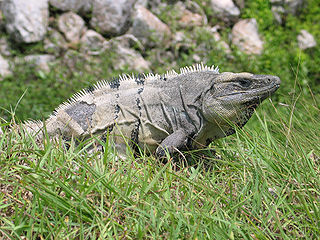
Ctenosaura is a lizard genus commonly known as spinytail iguanas or ctenosaurs. The genus is part of the large lizard family Iguanidae and is native to Mexico and Central America. The name is derived from two Greek words: κτενός, meaning "comb", and σαύρα, meaning "lizard".

Leiocephalidae, also known as the curlytail lizards or curly-tailed lizards, is a family of iguanian lizards restricted to the West Indies. One of the defining features of these lizards is that their tail often curls over. They were previously regarded as members of the subfamily Leiocephalinae within the family Tropiduridae. There are presently 30 known species, all in the genus Leiocephalus.
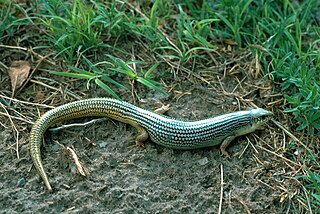
The Great Plains skink is a species of lizard endemic to North America.
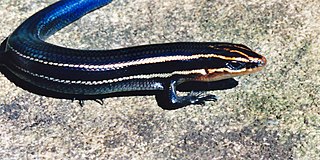
The four-lined skink is a species of lizard, which is endemic to North America. It is a medium-sized member of the Plestiodon skinks.

The razor-backed musk turtle is a species of turtle in the family Kinosternidae. The species is native to the southern United States. There are no subspecies that are recognized as being valid.
The Navassa curly-tailed lizard or Navassa curlytail lizard is an extinct lizard species from the family of curly-tailed lizard (Leiocephalidae). It is known only from the holotype, a female specimen from which it was described in 1868. A possible second specimen which was collected by Rollo Beck in 1917 was instead identified as a Tiburon curly-tailed lizard by herpetologist Richard Thomas in 1966.

The Martinique curlytail lizard is an extinct species of lizard in the family of curly-tailed lizard (Leiocephalidae).
The striped crayfish snake is a species of semiaquatic North American snake in the family Colubridae. The species derives its common name from its principal prey, crayfish. This snake is also called Allen's snake, the striped swamp snake, the striped swampsnake, or simply the swamp snake. It is endemic to peninsular Florida. Although rarely seen due to its secretive behavior, it can be found in large numbers in wet areas, with densities approaching 1,300 snakes per hectare.

The long-nosed leopard lizard is a species of relatively large North American lizard in the family Crotaphytidae. Gambelia wislizenii ranges in snout-to-vent length (SVL) from 8.3 to 14.6 cm. It has a large head, a long nose, and a long round tail that can be longer than its body. It is closely related to the blunt-nosed leopard lizard, which closely resembles the long-nosed leopard lizard in body proportions, but has a conspicuously blunt snout. The species G. wislizenii, once considered part of the genus Crotaphytus, is under moderate pressure because of habitat destruction but is categorized as "least concern".
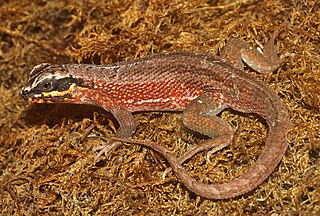
The Hispaniolan masked curly-tailed lizard is a lizard species from the family of curly-tailed lizard (Leiocephalidae). It is also known as the Hispaniolan masked curlytail, Haitian curlytail lizard and the green-legged curly-tail. endemic to the Caribbean island of Hispaniola.

Leiocephalus carinatus, commonly known as the northern curly-tailed lizard or saw-scaled curlytail, is a species of lizard in the family Leiocephalidae.
Leiocephalus loxogrammus, commonly known as the Rum Cay curlytail lizard and the San Salvador curlytail, is a lizard species in the family of curly-tailed lizard (Leiocephalidae). The species is endemic to The Bahamas and is only known to be found on San Salvador Island and Rum Cay.
Leiocephalus greenwayi, commonly known as the East Plana curlytail and the Plana Cay curlytail lizard, is a species of lizard in the family of curly-tailed lizards (Leiocephalidae). The species is native to the West Indies.
Leiocephalus inaguae, commonly known as the Inagua curlytail lizard, is a species of lizard in the family Leiocephalidae.
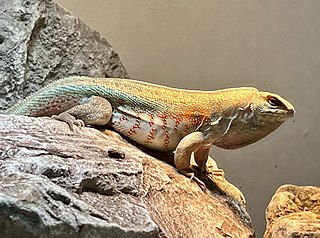
The Hispaniolan curlytail lizard, also known as the Hispaniolan khaki curlytail, the red-sided curlytail lizard, the red-sided curly-tailed lizard, or Schreibers's curly-tailed lizard, is a common lizard species in the family Leiocephalidae. It is native to Hispaniola in the Caribbean, and an introduced population is found in southern Florida. There are two recognized subspecies.

The Bahamian pygmy boa constrictor, also known as the Inagua trope or Bahama wood snake, is a species of nonvenomous snake in the family Tropidophiidae. The species is endemic to Great Inagua Island in the Bahamas.

Leiocephalus sixtoi, also known as the Hispaniolan dune curlytail, the dune curly-tailed lizard, or Sixto'scurly-tailed lizard is a species of lizard in the family Leiocephalidae. This species is endemic to the island of Hispaniola, and is only known in the sandy spaces of monumento natural Las Dunas de las Calderas, also known as Las Dunas de Baní.
Leiocephalus barahonensis, commonly known as the orange-bellied curlytail or Barahona curlytail lizard, is a species of lizard in the family Leiocephalidae. It is endemic to Hispaniola, including some outlying islands.

Leiocephalus psammodromus, commonly known as the Turks & Caicos curlytail and the Bastion Cay curlytail lizard, is a species of lizard in the family Leiocephalidae. The species is native to the Turks and Caicos Islands in the Caribbean Sea.
Leiocephalus roquetus, also known as the curlytail roquet or La Désirade curlytail lizard, is an extinct species of lizard in the family of curly-tailed lizard (Leiocephalidae). It was endemic to Guadeloupe.













